BMW was an early pioneer in the “electrification” space, though its first two models, the all-electric i3 city car and the plug-in i8 sports car, targeted narrow niche market segments.
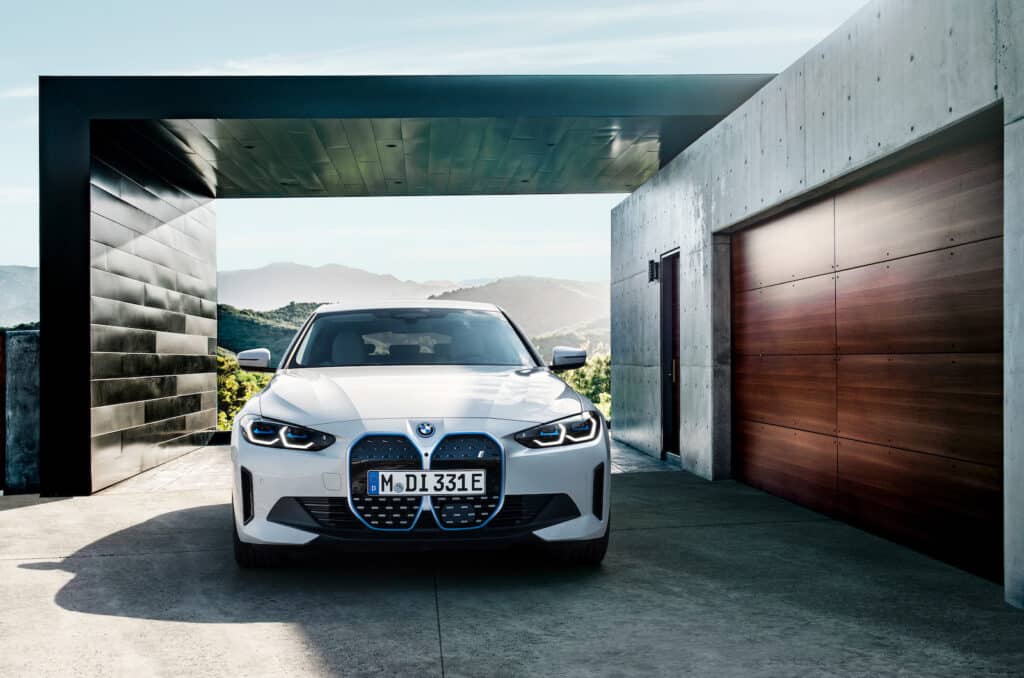
The Bavarian marque is now going after a more mainstream audience with an array of new offerings that include the i7, an all-electric version of the familiar 7 Series, the funky iX crossover, and the i4, essentially a battery-electric alternative to the 4 Series Gran Coupe.
I had the opportunity to spend a week with the i4 eDrive40 and, despite a few quirky issues, found it to be an ideal solution for those who might want to go all-electric with a minimal learning curve.
Overview
With the demise of BMW’s original i3 and i8, BMW is aiming to target more mainstream segments of the fast-growing EV market. That makes the i4 a critical entry for the Bavarian automaker.
At first glance you’re likely to find it difficult to distinguish the i4 from the more familiar 4 Series Gran Coupe until you spot the “i” badge. And, as with the conventional gas-powered model, the all-electric four-door coupe’s most distinctive – and controversial – feature is its oversized double-kidney grille.
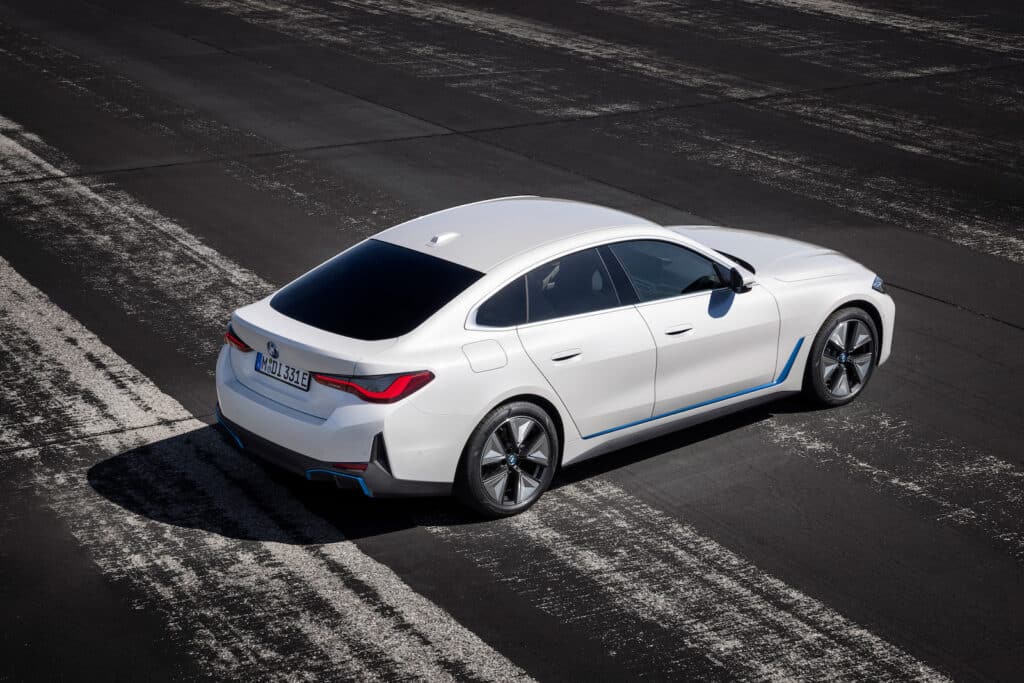
The i4 is available in a variety of different configurations, including both single and twin-motor packages. There’s also a 536-horsepower performance model, the i4 M50 which can launch from 0-60 in a mere 3.3 seconds, a full 0.2 seconds faster than BMW’s sporty M3 Competition. Credit the incredible, off-the-line torque that electric motors can deliver.
I spent my week getting familiar with the mid-range eDrive40, a single-motor version that, pushing a peppy 335 hp to the back wheels.
Exterior
From a design standpoint, the i4 is virtually identical to the familiar BMW 4 Series Gran Coupe. Easily the Bavarian brand’s most controversial product line. Credit — or blame, if you prefer — the vertical, oversized take on the Bavarian brand’s iconic double-kidney grille.
The immediate question is: why? You can make a case for a big grille — even such an awkward one — when you’ve got an internal combustion engine under the hood. Here, however, the grille is completely sealed off as there’s no need to force air into an engine compartment. There are some smaller intakes underneath the bumper to provide cooling air for the i4 drivetrain.
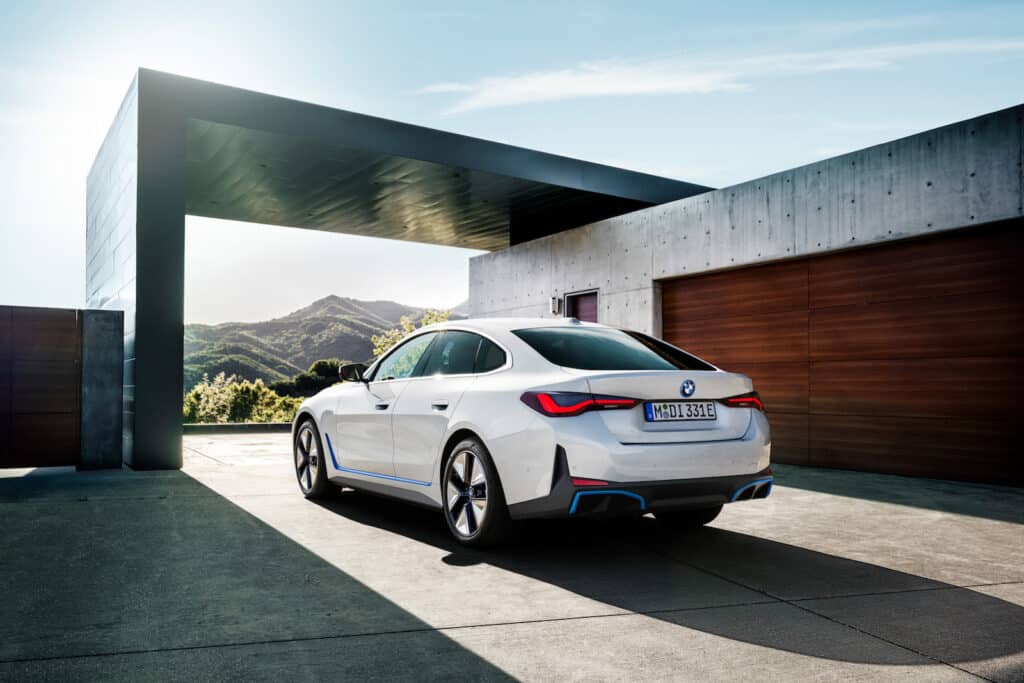
The all-electric model does get a few more subtle tweaks to enhance its aerodynamics — which translates into improved range and performance. But line it up alongside the standard 4 Series Gran Coupe and, if you can’t see the two models’ badges, odds are you wouldn’t be able to tell them apart.
Interior
During the past few years, BMW has struggled to come up with a clear strategy for its electrified future. It’s finally decided to develop a unique platform solely for its EVs — the route it’s taken with the iX. But the i7 and i4 are products of a now-outdated approach that uses the same underpinnings for both the gas and electric versions. One downside is that the layout — read: proportions — must accommodate a variety of different powertrain packages.
Unlike the iX, a dedicated EV, this means that the i4 has a longer nose and a compromised interior with moderately cramped rear seating. On the other hand, the hatchback design translates into substantial cargo space, especially with those rear seats folded down.
As with the exterior, the i4’s cabin is essentially lifted whole from the 4 Series, with only a few modest tweaks to reflect its all-electric nature. On the plus side, that gives you twin video displays that stretch out over more than half of the instrument panel. One of the downsides, however, is having to use the touchscreen to operate many basic vehicle functions, such as the seat heaters and coolers. BMW does maintain the familiar iDrive rotary controller and dedicated buttons, however, which provides an easy shortcut to many of those functions.
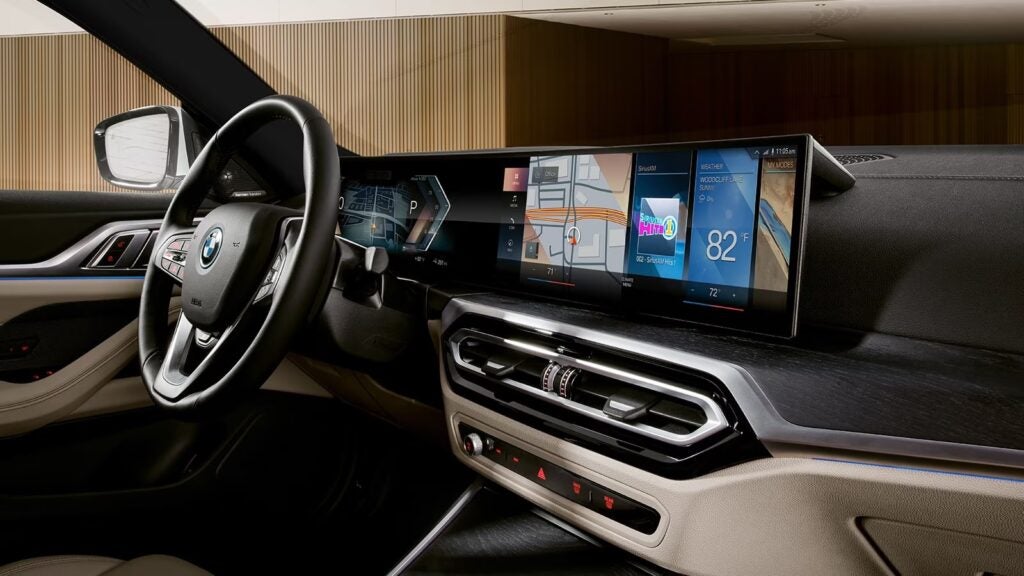
One disappointment was the cabin’s sound level. BMW engineers did a good job of masking out wind noise and, on smooth pavement, there’s little road noise, either. But get onto rougher concrete or asphalt and there’s a surprising amount of noise. Additional sound insulation would be appreciated.
Powertrain
There are an assortment of different powertrain configurations available with the BMW i4, starting with the base eDrive35 model and moving up to the sporty i4 M50. I spent a week flogging the i4 eDrive40. The name would suggest it’s equal to a 4.0-liter internal combustion package. But its performance was even stronger than you’d expect.
A single motor on the rear axle rear axle generates pushes out 335 hp and 317 lb-ft of torque. BMW rates it at 4.7 seconds 0-60, In Sport mode is where the i4 really shines, as that unleashes peak instant torque from the motor.
Range is EPA-rated at up to 301 miles with 18-inch wheels and tires, though it dropped to 282 with the 19-inchers on my test vehicle. After a week I found the range gauge in the instrument cluster to be more accurate than many competing EVs. And the system would occasionally adjust itself to reflect a more realistic range estimate based on current driving conditions — and how aggressive I was being with the throttle.
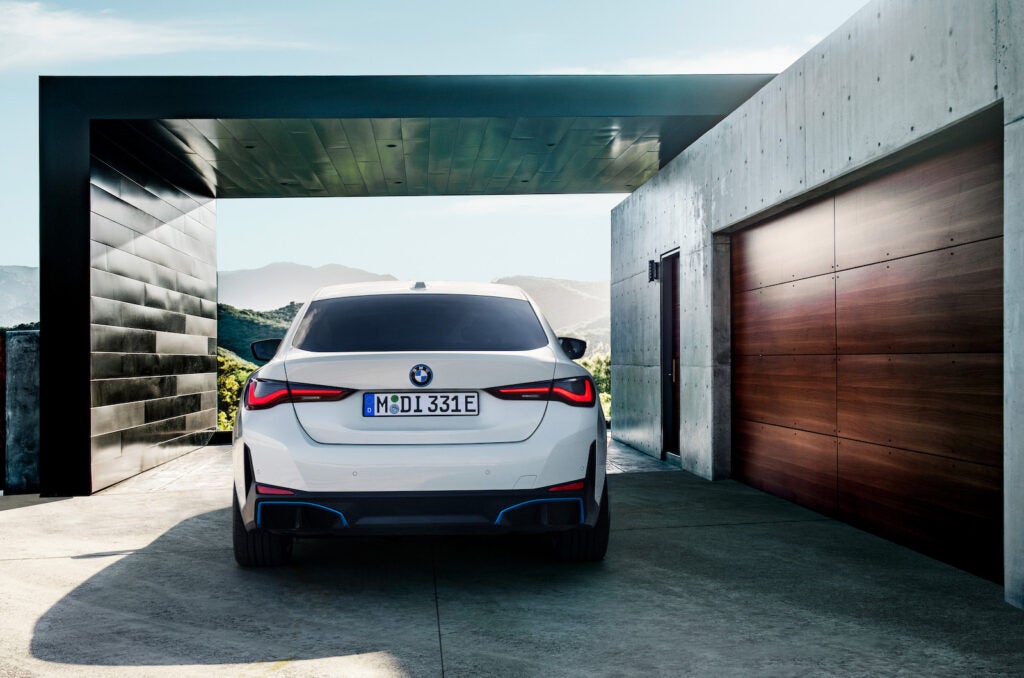
The 400-volt electric architecture in the i4 can handle up to a 200-kilowatt charger. (But more powerful systems will adjust automatically.) At that power the EV will go from a 10% to 80% state-of-charge in as little as 31 minutes. Less powerful systems will keep you tethered longer. And with a homestyle 240-volt Level 2 system expect to stay plugged in most of the night.
Safety and Technology
The i4 features a pair of digital displays: a 12.3-inch gauge cluster and a 14.9-inch infotainment screen. Both are high-resolution and easy to read. As has become more and more the norm, BMW moved a number of functions to the infotainment system, with only a relative handful of conventional knobs and buttons.
It helps to have the familiar iDrive which is surrounded by shortcut buttons for functions like navigation and media. But the latest iDrive system, version 14, places a dizzying array of tiles on the screen that can be awkward to work your way through to try to find various features and functions,
The base vehicle adds functions like Apple CarPlay and Android Auto, while providing a WiFi hotspot. Smartphone-style, over-the-air updates can be used to download software updates and, if BMW so provides, to add new features.
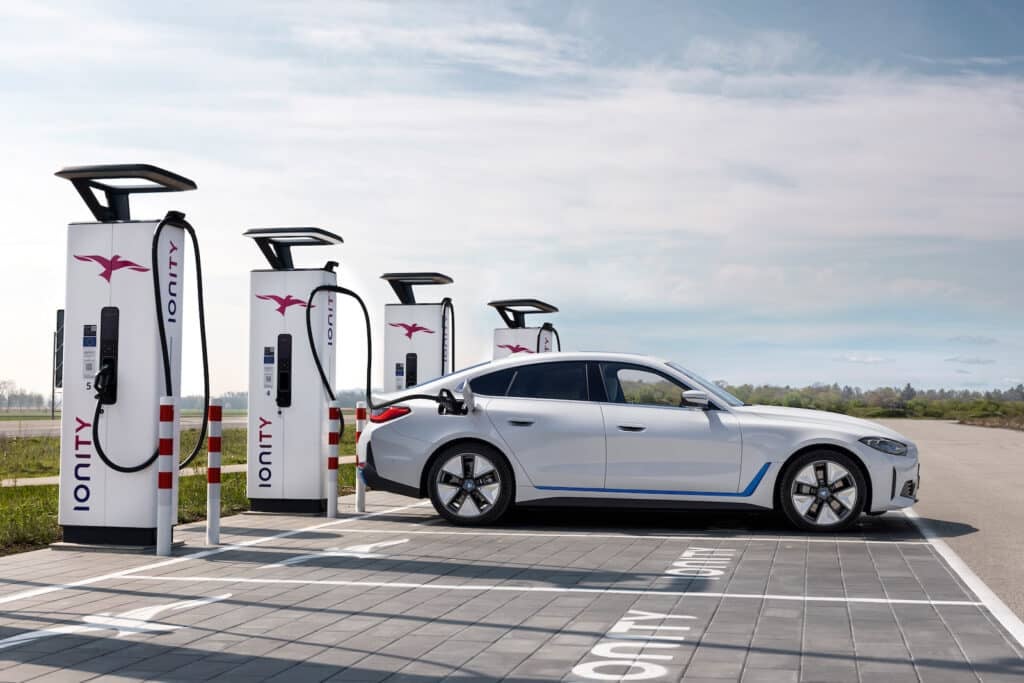
The i4 also is loaded up with advanced driver assistance technologies, including crash avoidance systems such as blind-spot detection, lane departure warning and lane-keeping assist. The adaptive cruise control also will bring the EV to a complete stop and then start up again when traffic clears.
Driving Impressions
BMW engineers have done a solid job making the i4 feel and drive like a conventional 4 Series. And while there is significant additional mass — the EV weighing in at just over 5,000 pounds — the low placement of the battery pack and motors actually translates into a lower center of gravity than a comparable 4 Series Gran Coupe.
Out on the road, the i4 is pleasantly nimble, though the steering is a bit numb. The rear-wheel drive i4 eDrive40 does suffer a bit from the lack of a front motor, especially where road surfaces are rough or wet. Slamming the throttle can result in a bit of tire slippage due to the way torque comes on instantaneously. The all-wheel-drive packages do help here, as does the M50’s larger, stickier tires.
A personal issue for me is the availability of 1-Pedal driving. Think of it as being similar to what happens when you downshift a manual transmission several gears. In most driving situations you can simply modulate the throttle, even coming to a complete stop, without having to jump back-and-forth from accelerator to brake. On the plus side, the i4 can switch to this mode. The downside is that getting to 1-Pedal is a bit complicated. You need to find the infotainment menu that regulates brake function and switch to its most aggressive setting. And, when driving, you set the shifter to “B,” rather than “D.”
Equally challenging is the task of adjusting the simulated drivetrain audio track. I personally like having an EV create a slight bit of artificial sound during hard acceleration and braking. But you can get stuck in a mode that creates a sci-fi like whine even when steadily cruising.
Wrap Up
BMW is still in the midst of transformation when it comes to its EV strategy. The new iX shows where it’s heading, with dedicated platforms for its upcoming battery-electric line-up. But, while sharing platforms for gas and electric models may create some compromises, the BMW i4 provides reasonable space and still delivers a surprisingly pleasant ride.
It could be a bit quieter. And it could be a little easier to sort through all the menu options in the iDrive system. On the other hand, you get the opportunity to truly personalize the way the hatchback operates.
You’ll pay a bit more than you would for a conventional 4 Series Gran Coupe, the i4 starting at $51,400 for the base eDrive35, and pushing to $78,770 for the M50 edition. But considering what some competing models are charging, you get plenty for the money.
2023 BMW i4 eDrive40 — Frequently Asked Questions
How much does the BMW i4 eDrive40 cost?
The various versions of the 2023 BMW i4 range in price from $51,400 to $78,770. The i4 eDrive40 starts at $59,245. Our well-equipped tester came in at $69,720, including $995 in delivery fees.
What is the range of the BMW i4?
The EPA estimates our i4 eDrive40 should get 282 miles per charge. It has a 99 MPGe rating.
Does the BMW i4 qualify for federal EV tax credits?
Under the revised rules in the Inflation Reduction Act, no BMW EV model currently qualifies for U.S. federal tax credits. The i4 may, however, qualify for various state incentives.
- SEO Powered Content & PR Distribution. Get Amplified Today.
- PlatoAiStream. Web3 Data Intelligence. Knowledge Amplified. Access Here.
- Minting the Future w Adryenn Ashley. Access Here.
- Buy and Sell Shares in PRE-IPO Companies with PREIPO®. Access Here.
- Source: https://www.thedetroitbureau.com/reviews/a-week-with-bmw-i4-edrive40/



